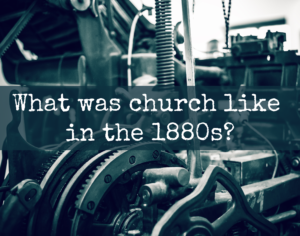Church in 1880: What was it like?
 The printing press had grown in popularity in North America by the 1880s. At that time, we still had no computers, fax machines, cars, radios, televisions, copy machines, aeroplanes, air conditioning, or the internet. For Church Administrators, there was no email marketing, Church Relationship Management (CRM), websites or Church Apps.
The printing press had grown in popularity in North America by the 1880s. At that time, we still had no computers, fax machines, cars, radios, televisions, copy machines, aeroplanes, air conditioning, or the internet. For Church Administrators, there was no email marketing, Church Relationship Management (CRM), websites or Church Apps.
Here is an interesting timeline of technological advancements since 1680:
Steam Engine & Gasoline Engine:
In 1680 – French physicist, Denis Papin, was the forerunner of the pressure cooker and the steam engine.
Mid-1880s – The gasoline engine, designed to power the first automobiles, was built by Karl Benz and Gottfriend Daimler.
Railways:
In 1830 – Trains ran at just 30 mph. George Stephenson’s “Rocket” pulled the first train on a commercial railroad which started the railroad boom.
In 1840 – Almost 3,000 miles of railway tracks were laid across America.
In 1845 – There were over a hundred railroad companies in America.
In 1846 – Pennsylvania Railroads was formed by the state legislature.
In 1850 – Only four to six railroad companies remained in America.
Telegraph & Telephone:
In 1842 – Samuel Morse demonstrated a working telegraph between two committee rooms in Washington DC.
When Congress voted in favor of investing $30,000 USD for an experimental telegraph line between Washington DC and Baltimore, 83 voted against it. Whereas, 70 did not vote, “to avoid the responsibility of spending the public money for a machine they did not understand.”
In 1852 – The New York Times article described the telegraph network as “the highway of thought.”
In 1877 – Inventors Elisha Gray and Alexander Graham Bell battled for the patent of new technology – the telephone.
Lightbulb:
1860 to 1865 – Every electric inventor began to work on what eventually became the lightbulb.
1879 – Edison waited for ten years, and then concentrated for a couple of years to deliver on this opportunity.
Typesetting & Printing:
In 1851 – The first issue of what later became The New York Times was published.
In 1858 – George Phones Gordon produced the Franklin Press that uses a foot pedal against the flat inked printing plate.
In 1886 – Ottmar Mergenthaler designed the Linotype for typesetting. Mergenthaler introduced a keyboard mechanism to assemble the letters and adjust them in a line. Despite resistance from the old craftsmen-typesetters, it became the “standard” by 1890.
Audio over Power Lines & Free Commercial Radio:
In 1920 – Radio broadcasting began with the broadcast of KDKA in Pittsburg, Pennsylvania.
In 1922 – Retired Major General George O. Squier patented the technology for piping audio over power lines.
In 1934 – The North American Company, under the umbrella of ‘Muzak’ started piping music into Cleveland homes. The Advent of free commercial radio was the end of Muzak’s market.
Photographic Film to Smartphone Camera:
1860s – Every bride wanted her photograph taken. In those days, photography required a heavy camera and an elaborate setting before the photos were taken.
Mid-1880s – George Eastman replaced the heavy glass plates with cellulose film.
1892 – The Eastman Kodak Company was founded. Within ten years, Eastman Kodak was the leader in photography.
In 1976 – Kodak enjoyed 89 per cent of market share in the United States, with photographic film products and the modern camera.
In 2013 – “Everyday, more photos are taken with an iPhone than any other camera.” – Apple
Next week, we will take a look at computers, the internet, websites, and what has changed in the last 20 plus years.
We are at the cusp of the 5th Industrial Revolution. The speed of change is not going to get any slower.



